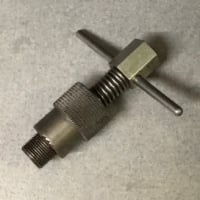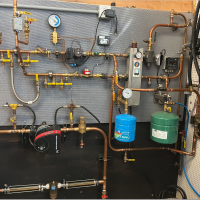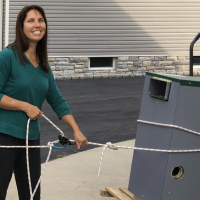Head loss
Comments
-
Did you first properly size the boiler based on a heat loss?
There was an error rendering this rich post.
0 -
If the emitters are designed for 180*f water your not going to save anything with a condensing boiler!0
-
I sized the boiler to the amount of BTU each cast iron radiator puts out. I used the attached chart to make the calculations.STEVEusaPA said:Did you first properly size the boiler based on a heat loss?
0 -
This, I presume, a hot water system? And you sized the boiler on the total square feet of radiation of your radiators times, I presume the 185 BTUh per square foot for 190 F water?
Um. No. That will give you the maximum amount of heat your system can put into the house from the radiators, and therefore the maximum net output of the boiler you can possibly use. What it doesn't tell you is anything about the actual heat loss of the house, which is how a hot water boiler should be sized (steam is sized on the basis of the square feet of radiation, but NOT hot water);
You need to take a step back and determine the actual heat loss of the house. Then you can use that to determine what size boiler you need. You can also use it to determine what temperature hot water you will need to be circulating, and that in turn will help you decide whether a conventional cast iron boiler will suit, or whether the additional cost and complexity of a modulating/condensing boiler is worth it.
Than you can begin to worry about pipe sizes and head loss...Br. Jamie, osb
Building superintendent/caretaker, 7200 sq. ft. historic house museum with dependencies in New England3 -
-
I hate to say this, but head-loss or pipe sizing calculations are seldom used in sizing residential hot-water heating systems. It's become a lost art for virtually anybody besides PhD engineering candidates or total amateurs. Experienced installers use their expertise, rules of thumb, and their experience. You would be best served by going to a qualified expert whose references you've checked.
Good luck.2 -
But competent installers do a heat loss first.Gilmorrie said:I hate to say this, but head-loss or pipe sizing calculations are seldom used in sizing residential hot-water heating systems. It's become a lost art for virtually anybody besides PhD engineering candidates or total amateurs. Experienced installers use their expertise, rules of thumb, and their experience. You would be best served by going to a qualified expert whose references you've checked.
Good luck.
There was an error rendering this rich post.
2 -
If your current system maintains the temperature on your coldest day, with 180 SWT, good chance 80% of the heating season you could run a lower SWT. Probably in to condensing mode on milder days. Plus it will modulate as the load diminishes.
A load calc, then a radiator assessment would answer the question.Bob "hot rod" Rohr
trainer for Caleffi NA
Living the hydronic dream2 -
Ist the reason for a outdoor temperature sensor so the SWT will lower on milder days keeping it in condensing mode?hot_rod said:If your current system maintains the temperature on your coldest day, with 180 SWT, good chance 80% of the heating season you could run a lower SWT. Probably in to condensing mode on milder days. Plus it will modulate as the load diminishes.
A load calc, then a radiator assessment would answer the question.0 -
Exactlyscatgo said:If your current system maintains the temperature on your coldest day, with 180 SWT, good chance 80% of the heating season you could run a lower SWT. Probably in to condensing mode on milder days. Plus it will modulate as the load diminishes. A load calc, then a radiator assessment would answer the question.
Ist the reason for a outdoor temperature sensor so the SWT will lower on milder days keeping it in condensing mode?Bob "hot rod" Rohr
trainer for Caleffi NA
Living the hydronic dream0 -
Ist the reason for a outdoor temperature sensor so the SWT will lower on milder days keeping it in condensing mode?Yes.8.33 lbs./gal. x 60 min./hr. x 20°ΔT = 10,000 BTU's/hour
Two btu per sq ft for degree difference for a slab0 -
Everyone is touching on bits and pieces of your answer but no one has actually come out and said that sizing on the connected radiation is going to oversize your system. So you have used the wrong criteria to select the proper size boiler. That is not uncommon, don't feel bad. That is why you came here. (The method you are using is for sizing steam boilers, not hot water boilers) They say the first step is the Heat loss calculation. That is correct.
Anyone that says that if you have radiators rated at 180° is not going to save you anything, is not looking at the big picture. Most boilers in the early part of the 20th century (During, and for several years after the Spanish Flu) will have largely oversized radiators because that were designed to heat the house to 80° indoors on the coldest day of the year with the windows open. Watch this video for reference https://www.youtube.com/watch?v=6bA5bwyW2BY... When were your radiators installed?
https://www.youtube.com/watch?v=6bA5bwyW2BY... When were your radiators installed?
So if your radiators were installed in the 1920s thru the 1940s you can be fairly certain that they are oversized. Now let's also look at the fact that your home may also have additional insulation that was not there when it was originally built. and you may have better windows than the original windows. all those factors will reduce the actual heat loss of the structure. and since we are not making steam that needs to heat up all that iron and steel before it starts to heat the house, then we do not need to worry about the amount of EDR of each radiator. All we need to know is what the actual loss of the home is at the design temperature. (what we used to call the coldest day of the year)
1. Heat loss first
2. Water temperature needed in the existing radiators to meet that heat loss.
3. Pipe size based on the needed heat loss
4. Pump needed to move that much heat thru the correct size pipes.
Numbers 1 and 2 are available by doing the math. There are heat loss calculation spreadsheets available online (Slant Fin used to have the most popular one. Not sure if it is still there)
Numbers 3 and 4 are explained in this book. https://www.xylem.com/siteassets/brand/bell-amp-gossett/resources/technical-brochure/fh-z100b-bg-zoning-made-easy-2.pdf. It is basic and to the point for non engineers like you and me. When it comes to pipe sizes needed you can find that information on pages 3, 4, and 5. Pages 6 and 7 tell you about pump head. Once you know that information you can select the boiler , the pump, and the proper pipe size
I hope this is a helpful comment.
Mr. Ed
Edward Young Retired
After you make that expensive repair and you still have the same problem, What will you check next?
4 -
This journal takes you through the steps for sizing also. It touches on the technology and application of ECM variable speed circulators also.
https://www.caleffi.com/sites/default/files/coll_attach_file/idronics_16_na_0.pdfBob "hot rod" Rohr
trainer for Caleffi NA
Living the hydronic dream1 -
A lot has changed since 1927.scatgo said:
I sized the boiler to the amount of BTU each cast iron radiator puts out. I used the attached chart to make the calculations.STEVEusaPA said:Did you first properly size the boiler based on a heat loss?
Houses have gotten tighter and better insulated.
What was installed 96 years ago is probably seriously oversized by todays standards.
Those radiators were sized for 180° supply water.
Get an accurate heat load / loss performed and find out exactly what size boiler you need. A room to room calculation will tell you if each radiator IS oversized and by how much.
Then you can decide if they'll do the job with lower water temperatures.0 -
Right now the boiler I have is set to 180 degrees. It works fine. The house will stay warm but the cost of natural gas is insane! The worst gas bill I would normally see during a cold winter would be 300 a month for about 3 months of the heating season. We had a very mild winter this year and I got a 500 + dollar a month gas bills for 4 months.pecmsg said:
A lot has changed since 1927.scatgo said:
I sized the boiler to the amount of BTU each cast iron radiator puts out. I used the attached chart to make the calculations.STEVEusaPA said:Did you first properly size the boiler based on a heat loss?
Houses have gotten tighter and better insulated.
What was installed 96 years ago is probably seriously oversized by todays standards.
Those radiators were sized for 180° supply water.
Get an accurate heat load / loss performed and find out exactly what size boiler you need. A room to room calculation will tell you if each radiator IS oversized and by how much.
Then you can decide if they'll do the job with lower water temperatures.
0 -
I jut talked to a tech support person at weil mclain. Ther Aqua balance boiler has a max supply temp of 190.0
-
My I respectfully point out that I agree that gas prices are up. Way up. That has nothing to do with how much heat your house loses. Even if your old boiler is really inefficient the best you can do is cut your gas use about in half -- which, I agree, would be significant. You might stand a chance -- after installing a new boiler -- of getting your gas bill all the way down to the "normal" figure you quote -- but not much lower than that at today's prices.scatgo said:
Right now the boiler I have is set to 180 degrees. It works fine. The house will stay warm but the cost of natural gas is insane! The worst gas bill I would normally see during a cold winter would be 300 a month for about 3 months of the heating season. We had a very mild winter this year and I got a 500 + dollar a month gas bills for 4 months.pecmsg said:
A lot has changed since 1927.scatgo said:
I sized the boiler to the amount of BTU each cast iron radiator puts out. I used the attached chart to make the calculations.STEVEusaPA said:Did you first properly size the boiler based on a heat loss?
Houses have gotten tighter and better insulated.
What was installed 96 years ago is probably seriously oversized by todays standards.
Those radiators were sized for 180° supply water.
Get an accurate heat load / loss performed and find out exactly what size boiler you need. A room to room calculation will tell you if each radiator IS oversized and by how much.
Then you can decide if they'll do the job with lower water temperatures.
The price you are paying is essentially political, however, and we try to avoid politics.Br. Jamie, osb
Building superintendent/caretaker, 7200 sq. ft. historic house museum with dependencies in New England0 -
-
Sorry, Sleepy Hollow is in NY

NJ Steam Homeowner.
Free NJ and remote steam advice: https://heatinghelp.com/find-a-contractor/detail/new-jersey-steam-help/
See my sight glass boiler videos: https://bit.ly/3sZW1el0 -
There is no such thing as an emitter that was designed for 180* water . Let your brain do some work before things leave your fingertips to the keyboardpecmsg said:If the emitters are designed for 180*f water your not going to save anything with a condensing boiler!
https://ocsind.com/wp-content/uploads/2019/08/OCS-Catalog-Pg-4-1.pdf
Don't be scared to further figure output at lower temps than what is listed here . I'll share a secret , there will continue to be heat transfer right down to the point of equilibrium , SHHHH , don't tell anyone
You didn't get what you didn't pay for and it will never be what you thought it would .
Langans Plumbing & Heating LLC
732-751-1560
Serving most of New Jersey, Eastern Pa .
Consultation, Design & Installation anywhere
Rich McGrath 732-581-38331
Categories
- All Categories
- 87.3K THE MAIN WALL
- 3.2K A-C, Heat Pumps & Refrigeration
- 61 Biomass
- 429 Carbon Monoxide Awareness
- 120 Chimneys & Flues
- 2.1K Domestic Hot Water
- 5.8K Gas Heating
- 115 Geothermal
- 166 Indoor-Air Quality
- 3.7K Oil Heating
- 77 Pipe Deterioration
- 1K Plumbing
- 6.5K Radiant Heating
- 395 Solar
- 15.7K Strictly Steam
- 3.4K Thermostats and Controls
- 56 Water Quality
- 51 Industry Classes
- 50 Job Opportunities
- 18 Recall Announcements










